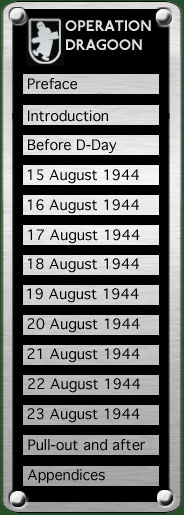
|
||
THE LUFTWAFFE IN SOUTHERN FRANCE Most (but not at first all) of the units based in the South of France came under the command Fliegerdivision 2, with its HQ at Montfrin, about 17.5km east-northeast of Nîmes. The Division itself, like all Luftwaffe forces in France, was subordinated to Luftflotte 3. At the beginning of August Fl.Div. 2's assets were as follows: Fernaufklärungsgruppe 5 This Gruppe consisted of two Staffeln of Ju 290s, hitherto employed on long-range maritime reconnaissance in support of the Atlantic U-Boat campaign. Fuel shortages and the onrush of the US Army, threatening the submarines' bases on the Atlantic coast, were soon to compel the Gruppe's withdrawal to Germany, where some of its planes passed into clandestine transport service with KG 200 — the decision had been taken in July to transfer three of its Ju 290s to the latter unit. Meanwhile it seems primarily to have been used for occasional weather reconnaissances when specialised aircraft were unavailable. It seems that the Gruppe was not called upon for the DRAGOON actions proper and on 21 August was ordered by Fl.Div. 2 to transfer to Mühldorf-am-Inn, 50 miles east of München. 2./Nahaufklärungsgruppe 13 NAG 13 had been in France since 1942, based initially at Avignon and then on the Atlantic coast, with Fw 190s and Bf 109s. When transferred to the Riviera in April 1944, the 2. Staffel was charged with overwater reconnaissance between the Spanish border and Corsica, the unfolding of events leading to a concentration on the latter. Reportedly, the unit's aircraft flew occasional anti-submarine missions, carrying special blast bombs. By mid-1944, 2.NAG /13 is said by a former Staffel member to have been a mixed unit of Fw 190 A-3/U4s and Bf 109 G-8s, their armament reduced to two machine-guns and a single cannon respectively. Around 5 August, the unit also received two converted Fw 190 A-8s from the aircraft park at Guyancourt. It is noteworthy however that no (recognisable) reconnaissance Bf 109s were found in Southern France although an Fw 190 A-4 was left behind at Cuers and other Focke-Wulfs were found completely wrecked on airfields in the Rhône Valley. It is possible that any surviving Bf 109s were pulled out to Caselle-Torino, Italy when the Staffel transferred there after the Allied landings but I have not been able to establish just how much of the unit, if any was able to get over the Alps. NAG 11 in Italy did receive two Bf 109 G-8s from other units during August and by 5 September 2./13 was re-equipping at Landsberg/Lech, Bavaria. The unit's Staffelkapitän was Oblt. Messner until mid-August when he was succeeded by Lt. Elster. 2./Seeaufklärungsgruppe 128 This was a Staffel of Ar 196 seaplanes based at Berre, with an outposted detachment, Arado Kette Perpignan, its aircraft operating from the Étang de Leucate. Tasks included anti-submarine patrolling, "security reconnaissance" (looking out for potential threats) and search and rescue work. 1.(F)/33 This Staffel had been stationed in the South of France for quite some time, flying maritime reconnaissance originally with only the Ju 88, its coverage regularly extending to Corsica, into Spanish waters and to the shores of North Africa. Following the Normandy invasion, the unit was sometimes called upon to carry out missions over the English Channel in conjunction with operations by the Division's bombers. Although perhaps a headache from the spares and maintenance angle, the variegated aircraft on strength oferred the capability for visual and radar reconnaissance (with FuG 200 Hohentwiel) and day and night photography. Aside from several Ju 188 Ds and Fs which (if ULTRA decrypts are any guide) were not much used, the Staffel had a selection of Ju 88s of the D, S and T series. The last two types were very fast aircraft, although the S was normally found in a bomber rather than reconnaissance role. Perhaps the "hottest" items in the inventory however were its few (three?) Me 410s, dispersed under trees at the north-east side of the Staffel's airfield of Saint Martin de Craux (known to the Allies as Les Chanoines) a little east of Arles. The Allies first learned of Messerschmitts with the unit on 4 June 1944, when VC+SL (Me 410 A-1, WNr. 148) and DQ+XY were handed over. At least two were specially adapted to carry GM-1 boosting equipment in the rear fuselage, necessitating removal of the remote-controlled 13mm machine-gun barbettes. Rear protection was provided by an improvised gun mount in the cockpit. These boosted aircraft were capable of a remarkable performance — taking photographs from 11,200 m. (about 37,000 ft.) — and extremely fast, as attested to by the frustration of Allied pilots who tried to intercept them. For example, on 24 July Spitfires of No. 92 Sqn. chased an Me 410, silver-painted and streaming black smoke from its exhausts, from Corsica to just off Nice; they reckoned it "the fastest encountered in this theatre", with a speed of more than 400mph.
The unit's Kapitän was Hptm. Rudolf Gruhle, killed on 22 September 1944 and posthumously promoted to Major in December; Staffelführer was Oblt. Sommer. Crews were billeted at Raphèle and in July had been ordered to sleep in their clothes in case of partisan attack. The problem was such that armour had been employed against the local Resistance and it was said by Staffel members taken prisoner in July that when a German aircraft had force landed in France recently, the crew had been surrounded partisans and could only be rescued by dropping parachutists. continued on next page...
|
|||

